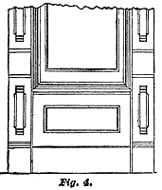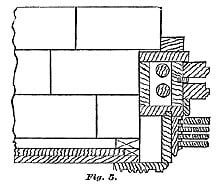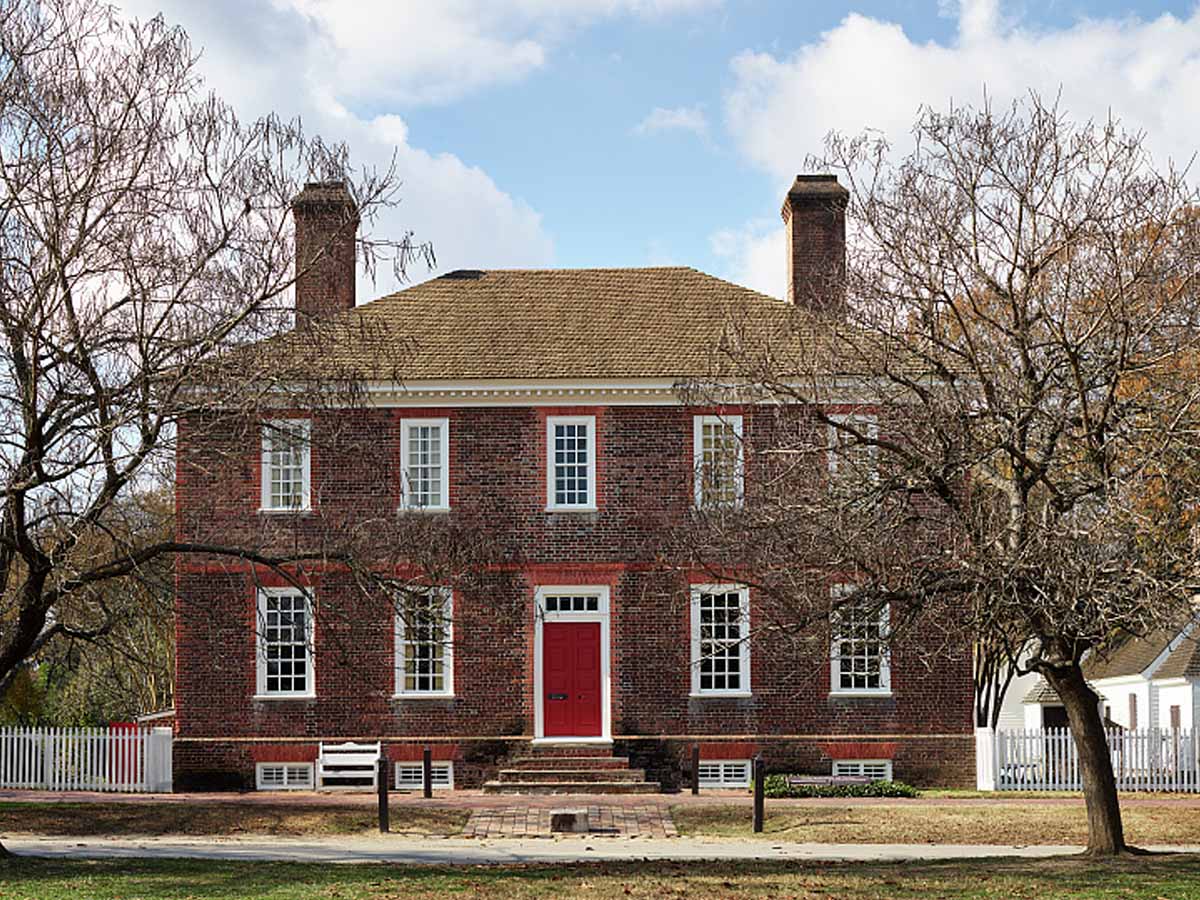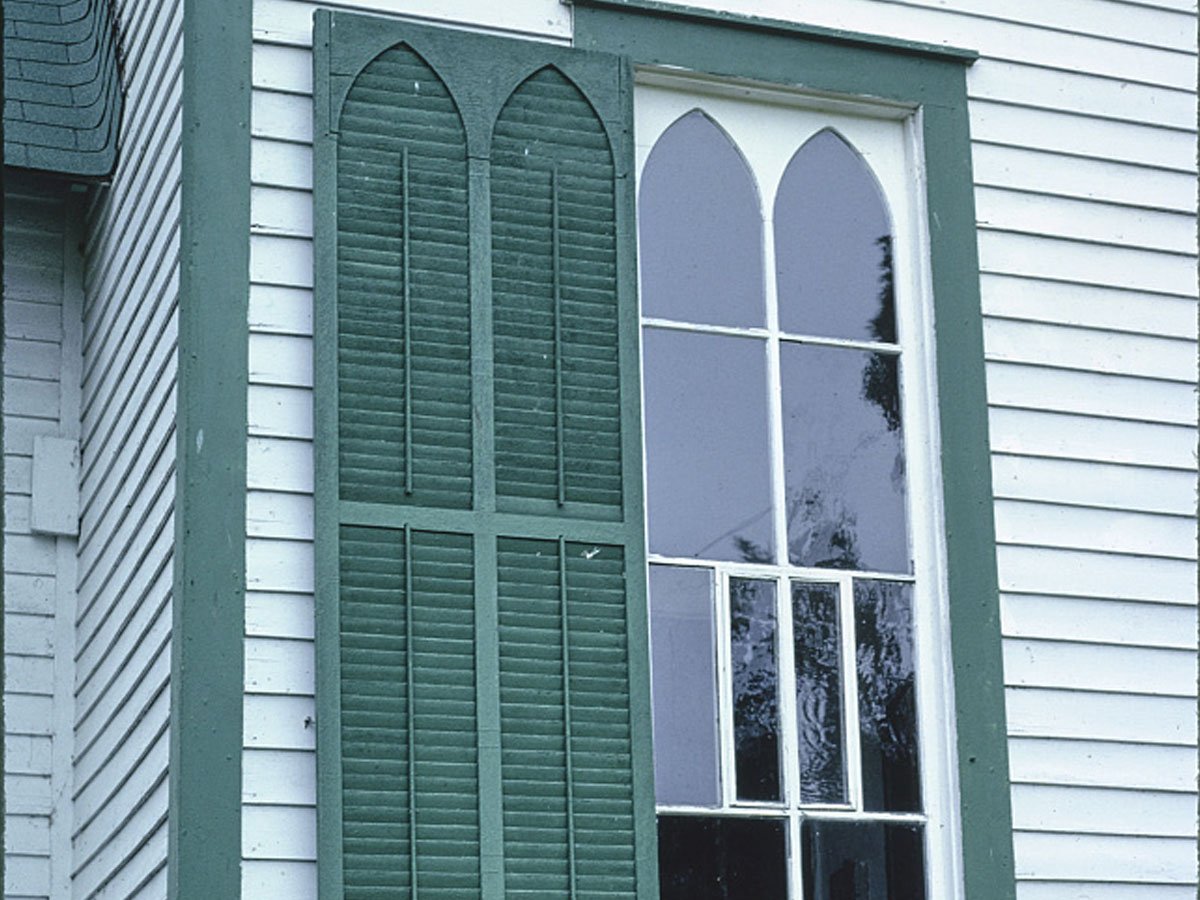Inside Window Sliding Blind
"In the Hartman blind, the inventor has succeeded in devising a sliding blind which can be readily attached to the ordinary window frame, and readily removed there from."
An advertisement circa 1880
(A failed attempt to re-invent the classic shutter.*)

The blind slides in the window frame, and remains in any desired position, being held in place by means of steel springs (concealed from view), as shown in Figs. 1, 6 and 7, which exhibit the appearance of the blind in use, and in various positions. They are made in three or more parts or sections, each moved independently of the other and, according to the size of the window to be furnished, in two, three or four panels in width. The sliding feature of these blinds has obvious advantages over the old form of hinged blinds, in that it avoids the unpleasant rattling which most of us are familiar with, and the tangling with the curtains, while it does not interfere with plants or flowers on the window sills.

These blinds are much less liable than the old style blinds to get out of order, and that they will in consequence outwear several sets of the old form. To this should be added the advantage that the Hartman blinds may be readily adapted to any ordinary window frame, and adjusted in working order in an hour by any mechanic of ordinary skill, and removed in a moment if necessary. To adjust in position a set of the old style hinged blinds is about a half days work. To state the case briefly, the Hartman blinds are claimed to have all the advantages of the old-style hinged inside blinds in respect to elegance of appearance, without any of their in conveniences. The evidence on this point will shortly given.
In regard to construction, the essential features will be understood from the following description: Where the window frame admits of it, the blind guides are carried entirely down to the floor, so that when desired the blinds may be neatly stored out of the way below the window sashes, and either in front of the panel-back, as shown in Fig. 2, or behind it, as shown in Fig. 4, which represents the blinds thus neatly stowed away in a pocket, with the panel-back in front of the blinds.



In this case, a hinged lid, or sill, is provided, which, when the blinds have been lowered into the pocket, closes it up. This is shown in section in Fig. 3, the dotted curve exhibiting the movement of the lid in opening or closing over the aperture in the panel-back. Figs. 3 and 4, for example, exhibit the above-named arrangement of a receptacle behind the window panel, into which the blinds may be stowed out of sight and covered with a suitable hinged sill.
The blinds in no way interfere with the simultaneous use of the ordinary window roller-shade, which may either be adjusted neatly between the sashes and the blinds, or, if so preferred, entirely inside the latter. Quite a variety of plans may be used to attach the blinds to the window frames.

Fig. 5 represents one of the many ways of constructing a window frame for the use of this blind, when the frames are made new, showing the location of the guide-way for the blinds, so set back on a sub-jamb as not to interfere with the taking out of the sash, and thus retaining the usual sash stop in the proper place. It is, however, not necessary to construct special window frames for the reception of these blinds, as they can readily be placed in any ordinary frame, as the guide-way can easily be attached to the jambs inside the sash, and the blinds fitted to slide in them.
Fig.7 represents a perspective view of a new style, lately introduced, which may present certain conveniences. It may be described as follows: It is termed the “Novelty,” and the blind section is made in the usual manner, but the inside divisions of the sections are made to swing on hinges, so as to open and shut at pleasure. The section slides up and down in connection with other sections, of which it constitutes a part. This swinging may be applied also to any of the other styles of blinds if desired. To remove the blinds from the window frames, it is only necessary to press each section sideways against the springs, flattening them far enough to enable the stile on the ether side of the section to pass out of the groove on that side, when the section is easily withdrawn; by reversing the operation, the section is replaced. The makers supply each set of blinds complete, ready for insertion, and furnished with an automatic, burglar-proof lock. They are made strong and durable, with mortise and tenon joints, and it is claimed for them that they will stand rougher usage than the usual hinged blind; while their construction and mode of operation is such that they are much less exposed to liability of becoming deranged in use. These blinds have grown rapidly into popularity, and we are credibly informed that thousands of them are now in use. This popularity promises to extend as architects and builders become more generally aware of the many conveniences and advantages which the innovation possesses over the old forms of inside blinds. The essential features of these devices are fully protected by patents, as a matter of course.
In closing our previous chapter on this very practical invention, we expressed the following opinion, which we see no reason to modify, and which we therefore repeat: “The Hartman sliding blind is extremely simple in its mechanical details, neat and tasteful in appearance, exceedingly convenient in respect to use, adjustment, removal and replacement, equally well adapted to public and private service, and from its construction and mode of operation, not liable to become disarranged or injured. We commend it to the favorable consideration of the fraternity of architects and builders as a meritorious device.
An illustrated catalogue and prices may be obtained of the makers, Hartman & Durstine, of Wooster, Ohio. The agents and manufacturers for the Dominion of Canada are Withrow & Hillock, Toronto, Canada.
* The Sliding Shutter was a failed and short-lived attempt to re-invent the wood shutter. This unusual configuration was tried during the 1880s and 1890s. Traditional hinged shutters, such as DeVenco manufactures, have proven superior for simplicity, functionality, and durability and have stood the test of time over two centuries. DeVenco, while catering to exacting specifications for authentic window treatments, has actually reproduced the sliding shutter as well as practically every other imaginable design for period homes, and are ready to meet the needs of the most demanding designers, architects, consultants and conservators.
Since Thomas Jefferson specified “venetian shutters” for his beloved Monticello, architects have favored the clean, functional look of interior shutters.








